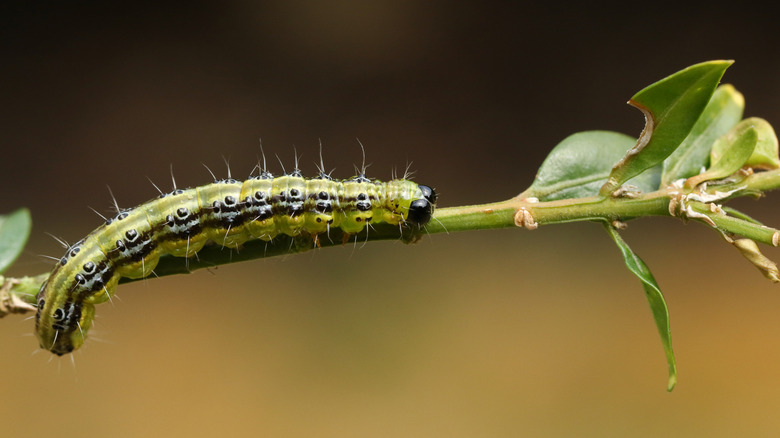Facts About The Stick Caterpillar
Among trees and bushes, you might have seen a caterpillar that looks like bark. This is a stick caterpillar. Stick caterpillars are fascinating insect larvae that use multiple methods to hide from potential predators. As their name suggests, they often resemble sticks. Their adult forms as moths continue the trickery, making them quite interesting insects to study.
Stick caterpillar characteristics
The stick caterpillar is the larval form of the peppered moth (Biston betularia). Peppered moths can be found in both the United Kingdom and in the United States. The stick caterpillar looks like bark and twigs, hence its nickname, and it mimics twigs in multiple ways to hide from predators. Their heads look like broken stems, and their legs look like thorns.
Stick caterpillars enjoy a variety of vegetation in their diet. They eat the leaves of plants of various sizes, including birch trees, oaks, poplars, beech trees, willows, hawthorns, blackthorns, hops, black currant, and more. Stick caterpillars reside in wooded habitats, hedges, and gardens.
Hatching from eggs in the middle of summer, stick caterpillars are active from early July through late September. After that, they form pupae (cocoons) underground to protect them through winter's chill.
Two camouflage methods of stick caterpillars
Stick caterpillars hide from predators in distinctly different methods, with the same result. As a caterpillar that looks like bark and branches, these larvae must mimic the shape and color of branches to succeed in their clever trickery. Potential predators would not want to eat bark or twigs, which is why the caterpillars hide in twiglike form.
The first method of mimicry is using postural camouflage. Postural camouflage means that the stick caterpillar changes its posture to hide. It does this by moving its body into a position that it can hold at an angle for long enough to avoid being detected by potential predators. Predators take longer to attack stick caterpillars that rest in stick-like angles than if they rested in flat positions. Some stick caterpillars even use postural camouflage to make themselves resemble bird droppings.
The other form of stick caterpillar mimicry involves changing the color of its skin. Researchers recently discovered that stick caterpillars could alter their coloration to match surroundings even while blind This discovery revealed the skill for the larvae to match their surrounding sticks without using vision to see what those sticks resemble. The caterpillar turns on genes for vision in its skin, giving it an additional way to use camouflage, turning its skin green or brown as needed.
Stick caterpillar moth
No less fascinating than its larvae, the stick caterpillar moth relies upon its own somewhat famous camouflage methods. The name of the stick caterpillar moth is peppered moth, for its coloring is mottled light and dark, like pepper. These moths match their surroundings to avoid predation, much as their caterpillars do. They do not change their coloring or body positions, however. They blend in.
Different variants of peppered moths match different kinds of lichen on tree bark. The lighter moths are classified as Biston betularia f. typica, and the darker moths are classified as B. betularia f. carbonaria. Middle-hued peppered moth variations are given the name B. betularia f. insularia. Famously, peppered moths revealed evolution in action, changing with the Industrial Revolution. Moths in the countryside stayed pale, while moths in the city turned dark to match the soot of industrial pollution. This change over time helped them to hide from predators better in the city.
Peppered moths range from 1.5 to 2.5 inches across in size. They can live for about one year. Peppered moth predators include birds such as nuthatches, robins, and flycatchers. You can help provide ideal peppered moth and stick caterpillar habitat by planting shrubs, ivy, and plants with abundant nectar.
References
- Science Magazine: These Caterpillars Can Camouflage Themselves, Even When Blindfolded
- Arizona State University – Ask a Biologist: Peppered Moth
- Butterfly Conservation: Peppered Moth (Biston Betularia)
- The Wildlife Trusts: Peppered Moth
- Scientific Reports: The Antipredator Benefits of Postural Camouflage in Peppered Moth Caterpillars
